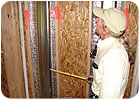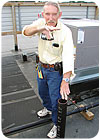
Installation errors and short-cuts can turn a black ink project into an ocean of red ink under the scrutiny of mechanical inspectors who are paid to make sure that HVAC equipment is properly in-stalled according to code and that the safety of building occupants and contractor's employees is never compromised.
That's one of the key reasons why The NEWS recently hit the road with two mechanical inspectors to learn some of the common mistakes installers make and to get advice on how to keep the corrective action checklist to a minimum number of pages. The inspectors featured in this article are Jerry Payne, mechanical inspector for the city of Wyoming, Mich., a suburb of Grand Rapids, and Bill Paquette, a heating and refrigeration inspector for the city of Farmington Hills, Mich., a suburb of Detroit. Both men have impressive backgrounds in the mechanical trades and both hold mechanical contractor licenses.
These men agree that their job is to keep an even keel for all contractors doing work in their jurisdictions and to show no favoritism. "We try and keep a level playing field for all contractors," said Payne, who works in a city with 288 registered mechanical contractors. Wyoming has been experiencing tremendous growth as it moves from a rural community into a vibrant suburb or a larger metropolitan area.
Farmington Hills is an older Detroit suburb where residential and commercial development has slowed down quite a bit compared to the more undeveloped city of Wyoming. The city currently lists 80 registered mechanical contractors. "I don't look at the contractors, I look at the permit," said Paquette. "I really don't want to know the contractor. That way, they all get the same treatment from me."
THE MOST COMMON MISTAKES
So what do inspectors find more often during mechanical equipment installations that raise an eyebrow - and a red tag from inspectors? Payne and Paquette listed some of the more common problems they encounter, both in residential and commercial installations."In residential installations I see a lot of water hose trying to be used for condensate drain lines," said Payne. "I see line sets that are not properly enclosed where they penetrate a wall. There are also a lot of times I'll see return air vents that are not sealed correctly or they have loose connections."
Payne thinks that a lot of problems originate from lack of training, resulting in poor workmanship. According to him, an installer has to know what an installation is supposed to look like to get it there. He cited an example of one contractor who installed HVAC equipment in an eight-unit apartment building.
"The work was done by a lowest-bid contractor who used untrained labor and wasn't around to supervise the work," he said. "I wound up writing 16 pages of violations."

Paquette added his own list of residential "no-nos." He noted that the new 13 SEER equipment requires different line sets and thermal expansion valve coils, something he is not sure that all contractors are aware of. He also said that equipment location is often a reason for code violations.
"I've seen installations of multiple condensing units where the space between each unit has been too tight," he commented. "Exhaust air from one unit is being sucked up into the intake air of another unit.
"Other problems include return air being blocked between building joists and location of exhaust intake terminations."
Paquette makes a habit of noting addresses of homes that have new chimney caps on them, often signifying a chimney repair, which could require the replacement of a chimney liner. "After I get a dozen or so addresses, I'll check to see if a permit was pulled to replace the liner," he said, noting that a permit is required for this type of work.
For commercial applications, both inspectors noted one very important installation that is often lacking; rooftop guide rails. "I'm a stickler for safety," said Paquette.

He added that the code in his city requires the installation of a permanent ladder for any building over 16 feet high.
Payne said that proper installation of smoke detectors is a common problem, too, especially for commercial contractors who are more experienced in the residential market.
"Not all contractors who go from residential to commercial installations are aware of the differences in what the codes will allow," he said.
One of his biggest concerns in Wyoming is the shift in responsi-bility for restaurant inspections from the Health Department to mechanical inspectors. "Now we are doing a job that normally wasn't ours to do," he said.
Paquette said he sees problems in some of the commercial installations where duct joints are improperly sealed.
"I question that requirement but it is code and I have to enforce it," he said. He also noted that a common mistake is the location of bathroom exhaust fans, which are often positioned too close to air intakes.

AVOIDING THE MISTAKES
While both inspectors commented that even the best contractors are prone to making some mistakes, the best way to keep violations to a minimum is to maintain current codebooks and keep abreast of changes in mechanical codes."People who are violators or those who are confrontational are those who have never bought or read a code book," said Payne. "These people typically rely on the guy behind the counter of a supply house who is telling them what the code requirements are for the job he is selling parts and equipment for.
"I came up through the business and know HVAC contractors. There is no need to be confrontational."
Payne believes that a lot of problems can be avoided if contractors and their employees go through the proper training.
"There should be more apprenticeship training for the guys coming up through the trade," he said. "If you learn to do the job right the first time, you can pick up your speed on other jobs as you gain more experience."

"Sometimes it is just human error that causes a problem. It is our job to pick up on that."
And sometimes it is an overlap - a conflict between trades - that leads to code violations. Paquette talked about one job where a plumber came in after a contractor had finished his work. The plumber was doing some welding and the sparks burned holes in the flex duct. The contractor was written up although it wasn't his fault.
"Some contractors will do a walk-through before the final inspection to ensure their work is still intact," Paquette said.
One other thing that can cause problems during an inspection is the lack of instructions on the equipment installations. The manufacturer's requirements are listed on the instructions, which often find their way into the trash, according to Paquette.
"Make sure the installation instructions are available," he said. "Don't let a cleaning crew throw them away."

THE SPIRIT OF COOPERATION
Both men agree that a good relationship between inspectors and contractors is important to understanding mechanical codes and ensuring future work in their jurisdictions. Contractors who know what inspectors look for can practice preventive measures.Payne thinks that the trade has come a long way in policing itself, especially its employees. "A lot of contractors are becoming aware of what their employees are doing after hours, too," he said. "Overall, the trade has come a long way in the last 6-8 years.
"Still, there are a few licensed individuals who are a problem and contribute to a bad image of the trade. They have few or no employees, fail to pull permits, and often are caught because they upset the customer."
Paquette sees the benefits of a good working relationship. "I like to think of my job as a partnership with contractors," he said. "But if the relationship becomes ad-versarial, everyone loses.
"Contractors can call me up anytime and I'll work with them. If I see something during a rough inspection that wouldn't be critical until a final inspection, I'll talk it over with the contractor. It is easier to fix a problem during the rough stages than the final stages.
"If I give them a fair shake, they will come back and bid on more jobs in Farmington Hills."
Paquette noted that the quality of mechanical inspectors also makes everyone's job easier, too. "Mechanical inspectors are required to be certified in continuing education," he said. "So now we don't have brother-in-laws of officials or people who can't get a job working in the inspection department."
And if a mechanical contractor is given a list of violations? It is in his or her best interest to work with inspectors to correct the problems. "In many cases, the mechanical contractor doesn't get paid until the work passes final inspection," said Payne.
Sidebar: Code Revisions
Bill Paquette, heating and refrigeration inspector for the city of Farmington Hills (featured in the main story), is also representing the HVAC trade as a committee member who is looking into revising the Forbes Mechanical Contractors Act, which passed in the early 1980s and currently governs state licensing of mechanical contractors.He said that some of the changes being discussed include:
"We've met several times over the past year," Paquette said. "The committee is made up of Lynn Briggs [former director of the Michigan Chapter of the Air Conditioning Contractors of America (MIACCA)], the Sheet Metal and Air Conditioning Contractors National Association (SMACNA), ACCA, the Associated Builders and Contractors (ABC), Consumers Energy, the Bureau of Construction Codes, and the Mechanical Inspectors of Michigan."
What kind of problems do you encounter during inspections? Do you have any code violation stories you'd like to share? Contact johnhall@achrnews.com and The NEWS will compile a list of the most common "no-nos" of HVAC equipment installations.
Publication date: 08/07/2006



